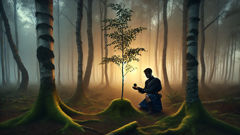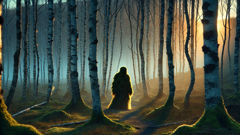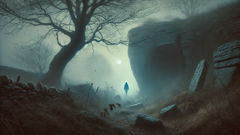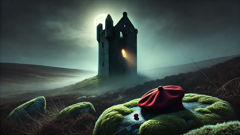Introduction
On the moss-still edges of a Scottish glen where birch trunks stood like patient, pale sentinels and the heather rolled in soft waves toward the stream, there lived a creature of the old days — the Ghillie Dhu. Folk in the nearest crofting hamlet spoke of him in low voices by peat fires, using cautious smiles when a traveller asked whether the tales were true. He was not like the capricious fairies that lured children across running water or led men astray with music. He was a solitary guardian of trees, a being of dark-green garments grown from moss and sap, whose hair tangled with leaves and whose feet left no clear print on the earth. Those who saw him at a distance remembered only that the wood seemed to bend around him, as if the branches recognized an old friend. The elders said he hailed from a time when the world still listened, when people named storms and thanked stones. In the hush before dawn, when mist hung in the hollows and the first skylarks announced the day in small bright armies, the Ghillie Dhu would move among the birches, tending baby shoots, mending torn bark with the slow patience of hands that understand roots. There is a gentleness built into his legend — a stubborn kindness that refuses human laws and promises to guard the green things even when the world beyond the glen speeds and forgets. This story follows his long, quiet watch through seasons and human troubles, through moments of mischief and mercy, and through one winter when the village itself stood on the verge of losing its memory of the old ways. It is, at its heart, a tale about a guardian who would rather risk loneliness than let the trees be forgotten.
Roots of a Quiet Guardian
The earliest accounts of the Ghillie Dhu do not read like a history but rather like the memory of a place: fragmentary, scented with peat and damp leaves, and stubbornly precise about details that matter to the earth. Shepherds and woodcutters, fishermen and the belligerent boys who raced on the parish green, all had versions. Some said he was older than the first pine planted on the ridge; others insisted he was born on the morning a particular birch shook free a nest of thrushes. No one could agree how tall he was, for different eyes measured him against different things — a span between two branches, the height of a child's shoulder, the length of the longest root. What threaded the stories together was always the same: he was a being of the woodland, solitary and steadfast, with clothing that seemed to sprout rather than be worn. Moss clung to his shoulders like a shoulder-wrap of living green. Lichens and small ferns formed a collar about his neck. When he moved, the wind through the trees softened, as though branches sighed in relief.

People of the glen learned early not to mistake him for a demon or a trickster. He did not steal cattle or whisper lies to lovers. Rather, his temper was the mood of the grove: patient, sometimes testing, and always protective. On occasions when villagers felled a sapling thoughtlessly to clear a space for a new fence or a poorly thought road, the next morning the felled stump would be returned, root-first, little rootlets newly clean and pushed into the soil as if by a gentle hand that refused to leave the wound. Fruit trees allowed to grow wild and young birches spared from the axe seemed to be blessed in small ways thereafter — a better crop of apples, bark that never split, bark-gnawed by rabbits sealed as if with a promise. Few could explain the how. Many said the Ghillie Dhu taught them to listen: to hear the slow, fibrous voice of tree sap moving within, to note the soft friction of bark against bark when a gust came up the valley.
He was no mere protector of timber. As keeper of the birches and of the spaces between, his loyalty extended to wildflowers that nodded underfoot, to ferns that unfurled at his passing, and to the wrens who nested in the crooks of old branches. Children who grew up under the watch of these stories learned the etiquette of the grove without books. When collecting kindling they would leave a sprig at the stump. Girls taking water to their mothers at dusk would lay a tin of cream on the bank for no reason anyone could recall, and an old woman once left a kettle to cool beneath an alder and later found it slightly warmed as if someone had rested a hand near the flame. Little acts of reciprocity knit the village to its woodland, and the Ghillie Dhu, though unseen, held to that braided life like a steady pulse.
There were nights, too, when his solitude bent toward mischief. Children who ran too far into the wood past curfew sometimes returned with hay tossed into their caps and leaves carefully braided into their hair the way the wind might braid. A man who would not mend the fence the day his sheep strayed through found, at dawn, his gate latched with twine of woven willow and the padlock turned the right way. Such acts were not petty revenge as much as small lessons laid down with the humor of someone who remembered a longer, slower world. Yet, the Ghillie Dhu's kindness had limits. Those who felled healthy trees for vanity or profit — men who thought a line of saplings were merely raw materials — found tools dulled and iron rusted. The neighbor who sold timber to the wrong buyer woke one morning to find his wagonwheel swallowed by soft earth where no earth had been before, the wheel mired as if the ground itself would not permit the theft. In the stories, these punishments were never violent; they were corrective, meant to steer human hands back to respect.
To understand his solitude is to understand the way the glen kept its memories. Time, in that country of hills and fog, was measured by the slow work of growth: the way a silver birch thickened over twenty years, how moss spread like green counsel, how summer birds left and winter ones returned. The Ghillie Dhu lived on those measures. He did not court companionship with men, perhaps because human lives, in their village, had a habit of forgetting and of changing faster than a tree could tell a story. But he watched carefully when friendships between child and wood sprang up — a little lad who would sit beneath a beech and read aloud from imagined books, a seamstress who stitched tiny flags and hung them in the branches for the thrushes to use. Such tenderities suited him, and the wood in turn sheltered those humans who had learned how to be small and quiet within it. Over time, the villages learned the rule of thumb: honor the birch, and the birch would honor you back.
The oldest tale of all — older than the parish's baptism records — speaks of an elder woman called Nessa, who once followed a wounded hare into the glen and found the Ghillie Dhu bending over it, binding a torn foot with lichen and an old strip of wool. She saw, in the act, that his kindness extended to the smallest of lives and that he measured the world by the needs of living things. When Nessa later returned to the hamlet, she did not declare she had met a fairy. She spoke instead of a man who cared for animals, and the word returned as a story: a guardian, a sprite, a ghillie of the dark. The names changed, but the heart of him remained: steward of the sap and the slow.
Winter Choices and the Memory of Trees
Winter in the glen wore its own counsel. Snow crept into the hollows and rimed the hedges. It was in one such winter that the Ghillie Dhu's steadiness was tested most sharply, and the village found its true measure. Times were hard. A new road surveyor's ink had marked the lands beyond the parish, and men with precise instruments had debated a route that would cut a swathe through the old birch stand. The road promised quicker passage to market and promised, in the ledger books, prosperity. The parish minister folded his hands and said the road would mean easier travel to the neighboring town's school. A young crofter, eager to deliver his produce faster, favored the change. Only the elders, who had grown up with peat smoke in their lungs and stories in their pockets, hesitated and argued that some things were not meant to be quantified by speed.

When an official letter arrived announcing the intention to fell a line of birches for surveyors' tracks, the village divided along a clean line like branches split by ice. Those who needed wages and goods for their families sided with progress. Those who wanted nothing to do with the survey claimed the trees by the force of memory. They recited little rituals and left small cups of cream at the gate. They went into the wood in pairs and listened at trunks, laying ears to windward to hear if any sap still spoke. It was during this tense time that the Ghillie Dhu's presence, always a quiet current, became a tide.
He did not come in the way of theatrical intervention. The stories that followed were small, stubborn acts that changed hearts more than laws. A surveyor's chain would knot inexplicably when unrolled across a chosen line. Paperwork would blow away in a gust that somehow always found the exact page. A hired sawman, when he approached the first marked birch, found his hands tremulous in a way that had nothing to do with weather, and he left a small carved toy beneath the tree the next morning — a toy he later claimed he had not put there. Rumors traveled faster than good sense: some said the Ghillie Dhu had simple spells; others said he sat on surveyors' chairs at night and sharpened their sense for the beauty of bark. Whatever the truth, the effect was accumulative. Men who had once been persuaded by the ledger pencils looked at the trees and remembered their own childhoods, the way their mothers had hung laundry under the birches so the sun would brighten it, the way the shade had held summer heat at bay. Sentiment often masks itself as nostalgia, yet here it took on a practical force. A business-minded man found himself giving up a convenient shortcut because he could not meet the pleading in an old woman's face when she said, simply, that the wood had a name and a right to be.
The Ghillie Dhu's intervention was most tender in a moment no ordinance could handle. On a night when an unusual storm leapt across the hilltops and peeled tin from roofs, a child strayed from the thatch and wandered into the fringe of the wood. The search began with lanterns and frantic prayers. Men called for dogs and pounded the bogs. The boy's mother, who had scolded him that afternoon for bringing a sparrow home, now could not remember admonitions because panic had replaced reprimand. They found signs of a small passage — a dropped shoe, a line of crushed heather — and then nothing. Eventually, the path led to a hummock of earth beneath a fallen birch where, to their astonishment, the child lay curled and asleep, wrapped in a blanket of moss and small fern leaves as if the wood had tucked him in. Near him lay a small sprig of thyme and a knot of willow, and when the mother reached toward the blanket she felt the steady warmth of someone invisible holding back the cold. There were no marks of violence, only a sense that the child had been tended.
After that night, the mood of the village turned. The road could be argued about in points and maps, but the lives that stitched through the place — memories, quiet rescues, small acts of protection — gained new weight. The minister, who had once believed in the slow, inevitable progress of roads and rails, found himself standing beneath the birches and listening to the sap as if it were sermon. He started signing petitions to spare the trees, not because he opposed progress entirely, but because he had seen how the forest tended the smallest among them. The crofter who had wanted faster market travel agreed, reluctantly, to seek another route for his cart. The compromise that followed honored both need and grove: reroute the survey slightly uphill, where the land had fewer ancient root systems and the heather lay thinner; leave the old birches as a corridor that the village would maintain forever.
Stories like this hardened into proverb. They were not only narrative comforts for children; they became practical lore, a way of organizing decisions around something older than appetite. The Ghillie Dhu rarely appeared in these resolutions as an agent in the ledger sense. He appeared as a memory-catalyst: an insistence that certain living things are part of a community's being. In later winters, when storms or blight struck, villagers would speak of the Ghillie Dhu in the same breath as remedies — old teas, the pulling of harmful shoots, and gatherings to nurse damaged roots. There is a subtlety to such a mythology: rather than demand worship or tribute, it binds people to small acts of stewardship. The road to market still came; the village still sold produce; children still played with sticks carved into soldiers. Yet they kept a corridor of birch that was named and respected and that sang, in its own slow way, the history of a people who had learned that to protect what is living is to protect what is human.
Beyond preservation, the glen's stories deepen into a meditation on solitude and duty. The Ghillie Dhu, as residents later told it, was content with being known but not owned. He did not court headlines or offerings beyond the tiny, necessary things that kept the world balanced — a left cup of cream, the mending of a broken fence, a knitted flag for a thrush. Villagers learned not only how to listen but how to act gently in the face of living systems. The legend, through winters and small rescues, taught a lesson: guardianship is less about spectacle and more about perpetual practice. The Ghillie Dhu's quiet vigil invited a reciprocal habit in the people around him. They learned to speak softly to the bark, to wait before the saw, to watch rather than conquer. In that arrangement, human life and woodland life stitched together into a pattern neither could have sustained alone.
As modern news creased across continents and new machines crept nearer to the parish in the years that followed, visitors sometimes came to the glen with cameras and polite questions. Few left unaffected. They had expected a figure of myth or a quaint amusement. Instead they found a place that insisted on being listened to, a quiet insistence embodied in the stories of an old guardian who wore the forest like a coat. Some returned to the cities to name their children after the birches. Others banked the memory as a quiet talisman and later taught their own small ones how to lay a sprig of thyme beneath a sapling. The Ghillie Dhu, whether spirit or metaphor, remained a touchstone — not because he commanded wonder but because he commanded care.
Conclusion
Legends seldom survive by force. They survive because they are useful, because they hold a simple truth dressed in story, and because they ask people to remember a way of being. The records of a solitary, moss-clad guardian may seem quaint or quaintly obsolete in an age of straight roads and wired maps, but the Ghillie Dhu's strength lay in his persistence — the steady tending of saplings, the small corrections that turned carelessness into respect, the nightly trimming of a wound no ledger could note. What the glen gained was not only spared wood but a habit of mind: to consider what else in the landscape deserved a name and a promise. There is a humility to the tale that is practical rather than pious. In quieter moments, when the birches whisper and the bracken exhales steam into a cold morning, the glen remembers the ancient reward of attention. Those who have read or heard this story may not expect to meet the Ghillie Dhu on a village lane, but they can feel the shape of his lesson in the care they give to the small living things around them. To honor a tree is, in miniature, to honor the future, for the act of remembrance is also an act of preservation. And if the story's charm lies in the singular figure of a guardian who prefers solitude and the company of roots, its power lives in the way people, warmed by the tale, choose — often without ceremony — to be gentle toward the green things that outlast and outpatient us all.













